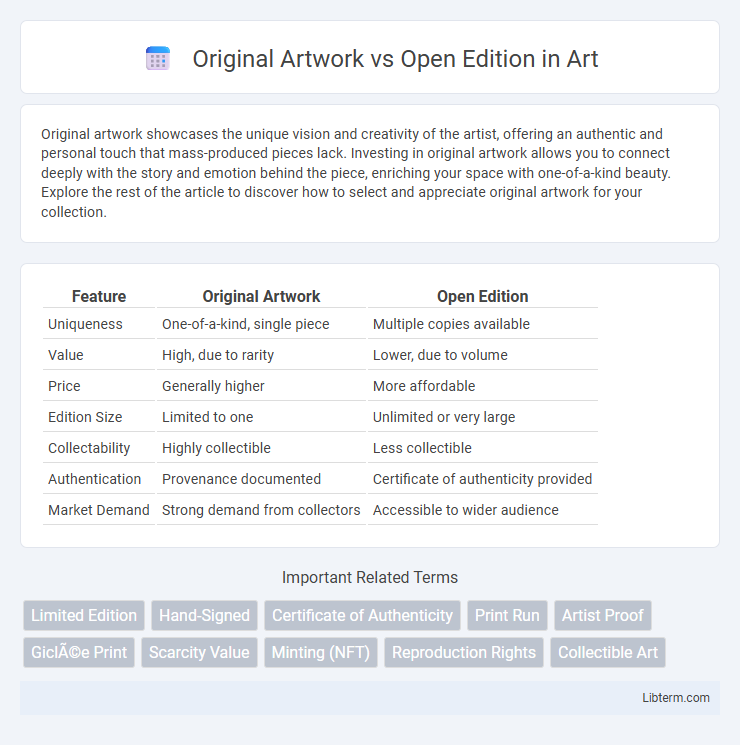Original artwork showcases the unique vision and creativity of the artist, offering an authentic and personal touch that mass-produced pieces lack. Investing in original artwork allows you to connect deeply with the story and emotion behind the piece, enriching your space with one-of-a-kind beauty. Explore the rest of the article to discover how to select and appreciate original artwork for your collection.
Table of Comparison
| Feature | Original Artwork | Open Edition |
|---|---|---|
| Uniqueness | One-of-a-kind, single piece | Multiple copies available |
| Value | High, due to rarity | Lower, due to volume |
| Price | Generally higher | More affordable |
| Edition Size | Limited to one | Unlimited or very large |
| Collectability | Highly collectible | Less collectible |
| Authentication | Provenance documented | Certificate of authenticity provided |
| Market Demand | Strong demand from collectors | Accessible to wider audience |
Understanding Original Artwork
Original artwork refers to a unique piece created directly by an artist, embodying their distinct vision, style, and technique. It holds intrinsic value due to its rarity, craftsmanship, and the personal connection it fosters between artist and collector. Ownership of original artwork often guarantees authenticity and potential for appreciation in value over time.
Defining Open Edition Art
Open edition art refers to digital or physical art prints produced without a fixed limit on the number of copies created, making them more accessible and affordable. Unlike original artwork, which is a single, unique piece crafted by the artist, open editions allow multiple collectors to own the same design or image. This format expands market availability and democratizes art ownership by removing scarcity constraints typical in limited edition prints.
Key Differences Between Original Art and Open Editions
Original artwork is a unique, one-of-a-kind creation that exists as a singular physical or digital piece, often accompanied by a certificate of authenticity and higher valuation. Open editions consist of prints or digital reproductions produced without a fixed limit, making them more accessible and affordable but less exclusive compared to originals. The key differences lie in scarcity, value retention, and collector appeal, with originals typically serving as investment-grade assets while open editions cater to mass-market demand.
Value and Rarity Comparison
Original artwork holds greater value and rarity due to its uniqueness and the direct hand of the artist, often commanding higher prices in the art market. Open edition prints lack scarcity since they are produced in unlimited quantities, reducing their investment potential and collectible status. Collectors prioritize originals for their exclusivity and potential appreciation over time, while open editions serve more for accessibility and decorative purposes.
Collector Appeal: Originals vs. Open Editions
Original artwork holds significant collector appeal due to its uniqueness, provenance, and potential for increased value over time. Collectors often seek original pieces for their exclusivity and the direct connection to the artist, which enhances rarity and long-term investment potential. Open edition prints attract collectors interested in affordability and accessibility but typically lack the scarcity and value appreciation found in original artworks.
Investment Potential in Art
Original artwork offers unique provenance and rarity, significantly enhancing its investment value due to limited availability and strong collector demand. Open edition prints, while more accessible and affordable, lack scarcity which diminishes their long-term market appreciation potential. Investors targeting high returns typically prioritize original pieces for their exclusivity and historical significance in the art market.
Authenticity and Provenance
Original artwork holds unmatched authenticity, as each piece is uniquely created and often accompanied by certificates of provenance detailing its history and ownership. Open edition prints lack exclusivity, making authenticity harder to verify, and they rarely provide detailed provenance records. Collectors prioritize original artworks for their verified provenance, which significantly enhances value and trust within the art market.
Display and Ownership Experience
Original artwork offers a unique display experience with singular authenticity and tangible value, often physically present in a home or gallery. Open edition prints provide broader accessibility, allowing multiple copies with consistent quality that can be displayed in various settings. Ownership of original pieces conveys exclusivity and potentially higher investment value, while open editions emphasize affordability and widespread enjoyment.
Navigating the Art Market Choices
Original artwork offers unique value through exclusivity and authenticity, often commanding higher prices due to its one-of-a-kind nature. Open edition prints provide accessibility with unlimited reproductions, appealing to collectors seeking affordability and broader availability. Understanding these options helps buyers strategically navigate the art market, balancing investment potential and personal aesthetic preferences.
Choosing the Right Art for You
Selecting between original artwork and open edition prints depends on your budget, space, and personal connection to the piece; original artworks offer unique value and provenance, while open editions provide affordability and accessibility. Consider the rarity and investment potential of original paintings, contrasted with the vibrant variety and flexibility of open edition prints. Your choice should reflect your aesthetic preferences, long-term goals, and how you envision the artwork enhancing your environment.
Original Artwork Infographic

 libterm.com
libterm.com